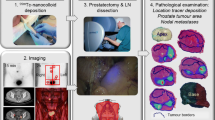Abstract
Purpose
Lymphatic mapping for prostate cancer can be used to determine therapeutic strategies. Sentinel node visualization requires sufficient nodal tracer uptake. We evaluated the effect of an increase in particle concentration on preoperative and intraoperative sentinel node depiction.
Methods
Enrolled in the study were 50 consecutive patients with prostate cancer. The first 25 patients (group A) received nanocolloid with standard labelling (0.4 ml 99mTc per 0.1 mg nanocolloid). The last 25 patients (group B) received nanocolloid with a reduced labelling dilution volume (0.4 ml 99mTc per 0.2 mg nanocolloid). The aimed injected volume and dosage were the same for both groups (225 MBq in 0.4 ml). Intratumoral tracer injection was followed by planar lymphoscintigraphy (15 min and 2 h), SPECT/CT and laparoscopic sentinel lymphadenectomy. Lymph node visualization was evaluated using a four-point scoring system (0 nonvisualization to 3 intense visualization) and count quantification on the 2-h anterior lymphoscintigram. In addition to the gamma ray detection probe, a portable gamma camera was used for intraoperative sentinel node visualization.
Results
Preoperative visualization in group A was 88% (mean 2.0 sentinel nodes per patient) versus 100% in group B (mean 2.6 sentinel nodes per patient). Visualization scores (p=0.008), total counts (p=0.001) and maximum counts per pixel (p=0.034) in the sentinel nodes were significantly better in group B. This also led to more efficient intraoperative detection of the sentinel nodes with the portable gamma camera (84% in group A versus 100% in group B).
Conclusion
Enhancement of the particle concentration may lead to significant improvement in sentinel node visualization and intraoperative localization in patients with prostate cancer. Further research regarding optimization of radiotracer labelling by changing the particle concentration is warranted.





Similar content being viewed by others
References
Holl G, Dorn R, Wengenmair H, Weckermann D, Sciuk J. Validation of sentinel lymph node dissection in prostate cancer: experience in more than 2,000 patients. Eur J Nucl Med Mol Imaging 2009;36:1377–82.
Jeschke S, Nambirajan T, Leeb K, Ziegerhofer J, Sega W, Janetschek G. Detection of early lymph node metastases in prostate cancer by laparoscopic radioisotope guided sentinel lymph node dissection. J Urol 2005;173:1943–6.
Meinhardt W. Sentinel node evaluation in prostate cancer. EAU-EBU Update Series 2007;5:223–31.
Vermeeren L, Valdés Olmos RA, Meinhardt W, Bex A, Van der Poel HG, Vogel WV, et al. Value of SPECT/CT for detection and anatomic localization of sentinel lymph nodes before laparoscopic sentinel node lymphadenectomy in prostate carcinoma. J Nucl Med 2009;50:865–70.
Vermeeren L, Valdés Olmos RA, Meinhardt W, Bex A, Van der Poel HG, Vogel WV, et al. Intraoperative radioguidance with a portable gamma camera: a novel technique for laparoscopic sentinel node localisation in urological malignancies. Eur J Nucl Med Mol Imaging 2009;36:1029–36.
Leijte JA, van der Ploeg IM, Valdés Olmos RA, Nieweg OE, Horenblas S. Visualization of tumor blockage and rerouting of lymphatic drainage in penile cancer patients by use of SPECT/CT. J Nucl Med 2009;50:364–7.
Brenot-Rossi I, Rossi D, Esterni B, Brunelle S, Chuto G, Bastide C. Radioguided sentinel lymph node dissection in patients with localised prostate carcinoma: influence of the dose of radiolabelled colloid to avoid failure of the procedure. Eur J Nucl Med Mol Imaging 2008;35:32–8.
Conway WC, Faries MB, Nicholl MB, Terando AM, Glass EC, Sim M, et al. Age-related lymphatic dysfunction in melanoma patients. Ann Surg Oncol 2009;16:1548–52.
Sato K, Krag D, Tamaki K, Anzai M, Tsuda H, Kosuda S, et al. Optimal particle size of radiocolloid for sentinel node identification in breast cancer – electron microscopic study and clinical comparison. Breast Cancer 2004;11:256–63.
Leidenius MH, Leppänen EA, Krogerus LA, Smitten KA. The impact of radiopharmaceutical particle size on the visualization and identification of sentinel nodes in breast cancer. Nucl Med Commun 2004;25:233–8.
Valdés Olmos RA, Tanis PJ, Hoefnagel CA, Nieweg OE, Muller SH, Rutgers EJ, et al. Improved sentinel node visualization in breast cancer by optimizing the colloid particle concentration and tracer dosage. Nucl Med Commun 2001;22:579–86.
Tsugawa K, Noguchi M, Miwa K, Bando E, Yokoyama K, Nakajima K, et al. Dye- and gamma probe-guided sentinel lymph node biopsy in breast cancer patients: using patent blue dye and technetium-99m-labeled human serum albumin. Breast Cancer 2000;7:87–94.
Silva N Jr, Anselmi CE, Anselmi OE, Madke RR, Hunsche A, Souto JS, et al. Use of the gamma probe in sentinel lymph node biopsy in patients with prostate cancer. Nucl Med Commun 2005;26:1081–6.
Mudun A, Sanli Y, Ozmen V, Turkmen C, Ozel S, Eroglu A, et al. Comparison of different injection sites of radionuclide for sentinel lymph node detection in breast cancer: single institution experience. Clin Nucl Med 2008;33:262–7.
Lerman H, Lievshitz G, Zak O, Metser U, Schneebaum S, Even-Sapir E. Improved sentinel node identification by SPECT/CT in overweight patients with breast cancer. J Nucl Med 2007;48:201–6.
Gommans GGM, van Dongen A, van der Schors TG, Gommans E, Visser JFM, Clarijs WWJ, et al. Further optimisation of 99mTc-Nanocoll sentinel lymph node localization in carcinoma of the breast by improved labelling. Eur J Nucl Med Mol Imaging 2001;28:1450–5.
Krynyckyi BR, Zhang ZY, Kim CK, Lipszyc H, Mosci K, Machac J. Effect of high specific activity sulfur colloid preparations on sentinel node count rates. Clin Nucl Med 2001;27:92–5.
Conflicts of interest
None.
Author information
Authors and Affiliations
Corresponding author
Rights and permissions
About this article
Cite this article
Vermeeren, L., Muller, S.H., Meinhardt, W. et al. Optimizing the colloid particle concentration for improved preoperative and intraoperative image-guided detection of sentinel nodes in prostate cancer. Eur J Nucl Med Mol Imaging 37, 1328–1334 (2010). https://doi.org/10.1007/s00259-010-1410-8
Received:
Accepted:
Published:
Issue Date:
DOI: https://doi.org/10.1007/s00259-010-1410-8




